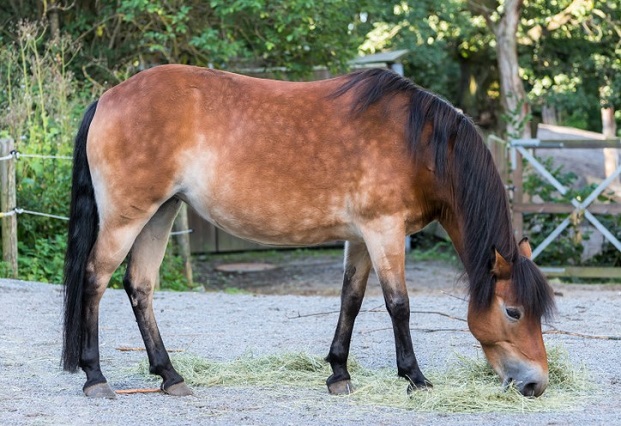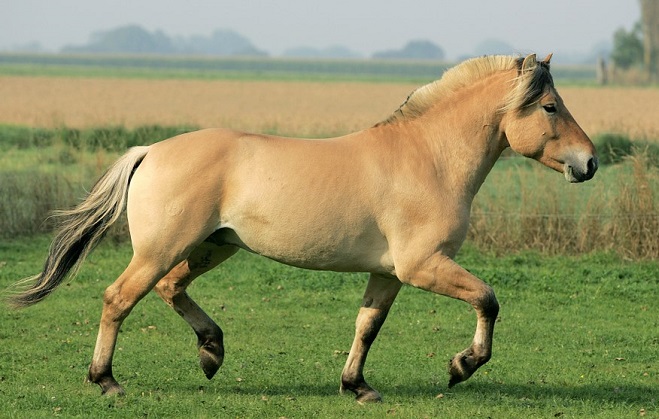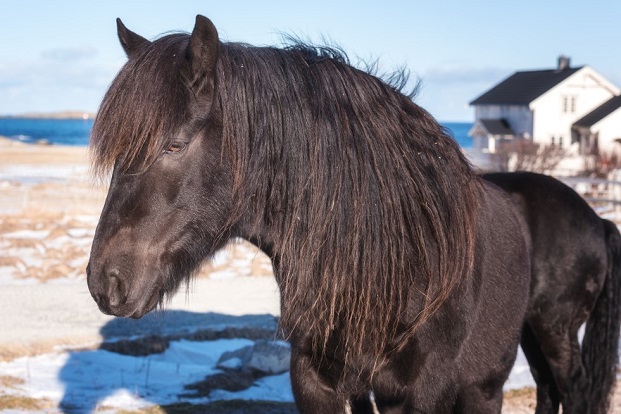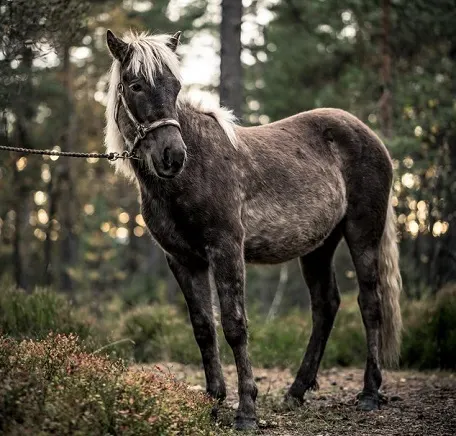From the Northern Lights to snow-peaked mountains, Scandinavia has some of the most breathtaking views in the world. There are also some remarkable horse breeds that call this subregion home.
Common horse breeds native to Scandinavia include the Gotland Pony, North Swedish Horse, Scandinavian Coldblooded Trotter, Swedish Ardennes, Swedish Warmblood, Norwegian Fjord, Dole, and Nordlandshest/Lyngshest.
These magnificent breeds play an important part in Scandinavian culture and are popular for their hardness and good looks.
Here are eight Norwegian and Swedish horse breeds.
1. Gotland Pony

Carlos Aranguiz / Shutterstock.com
The Gotland Pony is a very old Swedish breed, believed to be descendants of Tarpan horses. Also called Russ, they are native to the forest region of the island of Gotland.
Though horses have lived in Gotland for 4,000-5,000 years, the first official reference of Gotland ponies is from the 13th century. Throughout the 19th century, farmers in the area would use the ponies for draft work.
In the mid 19th century, their numbers began to drop and many horses were sold throughout England, Germany, and Belgium.
Wild herd numbers began to decline due to the deforestation of their native forests. By the beginning of the 20th century, there were only 150 Gotland ponies.
Farmers from Gerum and Lojst along with the Gotland Agricultural Society came together to save the breed. They fenced off 200 acres of land for the horses to roam across and also donated some horses to a stud farm. A semi-feral herd still remains on the island.
Today, there are around 9,000 Gotland ponies in Sweden, Denmark, Finland, and the United States. The breed has an elegant conformation with expressive eyes, a straight profile, muscular neck, short back, and strong legs.
Gotland ponies are on average 11.2 to 13 hands tall and come in almost every color, though bay and dun are most common. They are excel at dressage, eventing, driving and are a popular riding pony for children.
2. North Swedish Horse

Imfoto / Shutterstock.com
The North Swedish Horse is a relatively new horse breed that descends from the Dole. Though the breed is smaller in stature, the horses have a hardy build.
The studbook for the breed was established in 1909, with the North Swedish Association developing in 1924. In 1949, Country Horse Day began in order to register the North Swedish mares and stallions.
The breed consists of two types: the trotter and the draft horse.
North Swedish horses stand around 15 hands tall, coming in all solid colors, and display excellent stamina, endurance, and durability. They have deep chests, thick necks, short, strong legs, and a muscular body. As a versatile breed, they have many uses including forestry, agriculture work, riding, and harness racing.
3. Scandinavian Coldblood Trotter

The Scandinavian Coldblood Trotter consists of two studbooks, the Norwegian Coldblood Trotter and the Swedish Coldblood Trotter.
These hardy but fast horses are the results of breeding lighter, fast horses with native coldblooded farm horses, such as the Dole or the North Swedish Horse.
The objective of the Scandinavian Coldblood Trotter is to produce a horse that is fast, powerful, and smooth while being more refined than the Dole and North Swedish Horse.
Scandinavian Coldblood Trotter is heavier and stronger than other trotting breeds such as the Standardbred. They often have thicker coats than most trotting horses, allowing them to survive harsh winters.
The Scandinavian Coldblood Trotter is a popular choice for harness racing throughout Scandinavia. They stand around 15 hands tall and are commonly bay or black, though they can be other colors as well. These athletic horses have compact, muscular bodies, refined legs, and square heads.
4. Swedish Ardennes

Rolf_52 / Shutterstock.com
The Swedish Ardennes breed developed from crossing imported Ardennes horses from Belgium and France with North Swedish horses. The breed was created in the 19th century to meet the agricultural needs of farmers.
In 1872, Count C.G. Wrangel began importing Ardennes horses and breeding them with local North Swedish stock. By crossing Andrennes with North Swedish horses, they were able to improve their size while still maintaining their ability to withstand cold climates. A studbook for the breed was established in 1901.
Swedish Ardennes horses are a popular choice for agriculture work, hauling timber, and driving throughout Sweden. They are on average 15.2 to 16 hands tall and are predominantly black, bay or chestnut in color.
Swedish Ardennes horses have long manes and feathers on their legs, with a muscular build, short, thick neck, and deep chest.
5. Swedish Warmblood

Rolf_52 / Shutterstock.com
Athletic and agile, the Swedish Warmblood has been bred for riding for centuries. To improve the native Swedish stock, Spanish and Friesian horses were imported in the 16th century.
Throughout the 19th and 20th centuries, Arabian, Hanoverian, Thoroughbred, and Trakehner blood was introduced to Swedish stock used by the military.
In 1874, the government began an examination system in order to consolidate the various breeds. This led to the development of the Swedish Warmblood breed.
The Swedish Warmblood Association (ASHV) was formed in 1928 and they have controlled the breeding program since the 1970s when the army stopped using horses. They have gone on to excel as sport horses, competing at the highest levels including the Olympics.
Swedish Warmbloods stand around 16-17 hands tall and are most commonly chestnut or bay, though they can be other colors as well. They are athletic horses with graceful necks, strong legs, and a well-muscled body. Swedish Warmbloods excel in dressage, jumping, and eventing.
6. Norwegian Fjord

slowmotiongli / Shutterstock.com
The Norwegian Fjord, or Fjord, is one of the oldest and purest horse breeds in the world, going back 4,000 years. Herds of Fjords roamed Norway after the last Ice Age and have been selectively bred for 2,000 years.
Fjords are easily recognizable by their distinct look, with 90% of horses being brown dun in color with primitive markings. The other 10% are red dun, gray, white, or “uls” dun or yellow dun.
Their manes are dark in the middle and white on the outside. In order to showcase this, their manes are roached, with the white outsides cut shorter than the black middle.
In the late 1800s, Dole blood was introduced to the breed. However, the experiment proved to be a failure and all Dole blood was eliminated from the breed. Today, they are one of the most popular breeds in Norway and are also found all across the world.
Fjords have an elegant head, crested neck, muscular body, and strong legs. They generally stand 13.2- 14.2 hands tall and are popular for their calm, friendly personalities. Fjords are a versatile breed, excelling at dressage, trail riding, jumping, western pleasure, and driving.
Also Read: 10 Interesting Facts About Norwegian Fjord Horses
7. Dole

Uhryn Larysa / Shutterstock.com
The Dole, also known as the Dølehest, Dole Trotter, and Dole Gudbrandsdal, originates from the Gudbrandsdal valley in the east of Norway. Though the breed goes back hundreds of years, organized breeding began in the mid 19th century.
The first studbook was formed in 1941 and the association was founded in 1947. The breed split into two classes, the heavier draft type, the Dole Gudbrandsdal, and the lighter type, the Dole Trotter. The lighter type was crossed with Thoroughbred, Arabian, trotting, and draft bloodlines to create the Dole Trotter.
While Dole Trotters became popular harness horses, Dole Gudbrandsdals were in high demand during WWII thanks to their hardy nature.
In 1967, the National Dølehorse Association was formed to promote the heavier draft type, while the studbook for the Dole Trotter remains separate. However, as interbreeding has increased between the two types, the distinction of the two has become less prominent.
Dole horses have a straight head, muscular neck, deep chest, strong body, and powerful hindquarters. They generally stand between 14.1- 16 hands tall, coming in many colors and often sporting feathering on their legs.
Dole horses have many uses including pack work, agricultural work, harness racing, riding, and driving.
8. Nordlandshest/Lyngshest

A.Film / Shutterstock.com
The Nordlandshest/Lyngshest, or Lygen, is a small horse breed from Norway. Experts don’t know much about their origins, but the first documentation of the breed dates back to 1898, in Lyngseidet.
Organized breeding began in the 1930s, however, WWII caused the breed’s numbers to significantly drop. The breed remained endangered until the 1960s, but their numbers are back up today thanks to dedicated breeders.
In 1968, local breeders gave the horses the name Nordlandshest. However, this name upset breeders in Lyngen who referred to the horses as Lyngshest.
As a compromise to the dispute, both Nordlandshest and Lyngshest became official names of the breed.
Nordlandshest/Lyngshest horses are on average 12.3 to 13.3 hands tall and come in a variety of colors including chestnut, bay, black, palomino, buckskin, and gray. They have strong yet light builds and sometimes have light feathering on their legs. Their willingness to learn and easy-going personalities make them ideal for riding, driving, and pack work.
Source: horseyhooves.com








